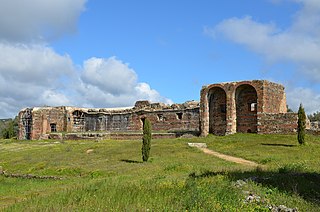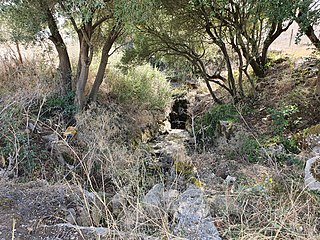
São Domingos de Rana is a civil parish of the Portuguese municipality of Cascais, part of the Greater Lisbon subregion. The population in 2011 was 57,502, in an area of 20.36 km². The parish includes the localities Abóboda, Cabeço de Mouro, Caparide, Matarraque, Outeiro de Polima, Polima, Rana, Talaíde, Tires, Trajouce and Zambujal.

Conímbriga is one of the largest Roman settlements excavated in Portugal, and was classified as a National Monument in 1910. Located in the civil parish of Condeixa-a-Velha e Condeixa-a-Nova, in the municipality of Condeixa-a-Nova, it is situated 2 kilometres (1.2 mi) from the municipal seat and 16 kilometres (9.9 mi) from Coimbra.
Municipium Cives Romanorum Felicitas Julia Olisipo was the ancient name of modern-day Lisbon while it was part of the Roman Empire.

The Roman ruins of São Cucufate is a Romanesque archaeological site, located on the ruins of a Roman-era agricultural farm in the civil parish of Vila de Frades, in the municipality of Vidigueira, in the southern Alentejo, Portugal. The convent, which dates back to Middle Ages, was dedicated to the martyred saint Cucuphas.

Mirobriga or Mirobriga of the Celts was an ancient town in the westernmost part of Lusitania during the Iron Age and Roman Times that was mentioned by Pliny the Elder and Ptolemy.

The Castle of Paderne is an ancient fortification located in the civil parish of Paderne, municipality of Albufeira, in the Portuguese Algarve. It was constructed in the later 12th century by Berbers, in an area around 7.5 kilometres (4.7 mi) inland.

The Fort of Nossa Senhora da Rocha is a medieval castle situated in the civil parish of Porches, in the municipality of Lagoa in Portuguese Algarve. Inside the fort is the Chapel of Nossa Senhora da Rocha, of uncertain date.

The Roman Ruins of Cerro da Vila are the remnants of a historical villa in the Algarve region of southern Portugal. Its vestiges lie in the vicinity of the resort and marina of Vilamoura, in the civil parish of Quarteira, municipality of Loulé Municipality.
The Roman villa of Vale do Mouro is a Roman settlement situated in the civil parish in the municipality of Meda, excavated since the early 21st century by archaeologists.

The Roman ruins of Santo Andre de Almoçageme is a Portuguese archaeological site located in the rural civil parish of Colares, in the municipality of Sintra. It includes a group of structures with typological, stylistic or historic value, whose structural elements are worthy of preservation.

The archaeological site of Colaride, is a Roman necropolis in a natural cave, located in the Portuguese civil parish of Agualva e Mira-Sintra, municipality of Sintra.

The Roman ruins of Casais Velhos are the remains of a Roman town, in the municipality of Cascais, Lisbon District, Portugal that included baths, two cemeteries, remains of a wall and ceramic artifacts.

The Roman villa of Alto da Cidreira is a Roman villa in the civil parish of Alcabideche, municipality of Cascais, in the Lisbon District of Portugal. Although known since the 1890s, this site has largely been neglected by archaeologists, resulting in destruction of artefacts, including Roman era mosaics, a bath complex and an olive oil cellar.
The Roman villa of Almoinhas is a Roman villa in the civil parish of Loures, municipality of Loures, dating to the first to fifth century AD.
The Roman villa of Outeiro de Polima is a Roman villa in the civil parish of São Domingos de Rana, in the Portuguese municipality of Cascais, dating from the 1st to 6th centuries AD.
The Roman villa of Quinta da Bolacha is a Roman villa in the civil parish of Falagueira-Venda Nova, municipality of Amadora, with an occupation dating from the 3rd and 4th century. It is commonly associated with the nearby Roman aqueduct, as well as the agricultural activities and Chalcedony mining occurring in the district.

The Roman Thermae of Maximinus, are the archaeological ruins of a monumental building and public baths, whose construction was integrated into the urban renewal of the civitas of Bracara Augusta, the Roman provincial capital of Gallaecia. The large public/civic construction consisted of a building, housing the baths and a theatre, although the archaeological excavations continue.

The Archaeological site of Cabeço do Vouga, also known as Castelium Marnelis, is an archaeological site in civil parish union of Trofa, Segadães e Lamas do Vouga, in the municipality of Águeda, in central Portugal. It is classified as a Property of Public Interest, and dates back to the Iron Age.

The Castle of Pena de Aguiar is a medieval castle, alternately the Castle of Aguiar da Pena, situated in the civil parish of Telões, in the municipality of Vila Pouca de Aguiar, in the Portuguese district of Vila Real.

The Roman villa of Freiria is a Roman villa in the civil parish of São Domingos de Rana, in the Portuguese municipality of Cascais.

















